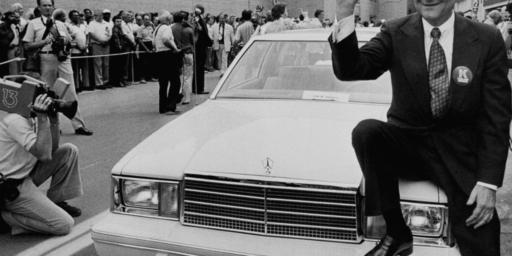GM and UAW Both Win?
This morning’s deal between GM and the UAW was a win for both sides, AP Auto Writers Dee-Ann Durbin and Tom Krisher contend.
General Motors Corp. won its struggle to unload $51 billion in retiree health costs and improve competitiveness in the latest round of contract talks with the United Auto Workers, but not without a short-lived strike that wrung promises out of GM to keep jobs at U.S. plants.
The two sides tentatively agreed Wednesday to a groundbreaking agreement that allows GM to move its unfunded retiree health care costs into an independent trust administered by the UAW. The union also agreed to lower wages for some workers. In exchange, the UAW won commitments from GM to invest in U.S. plants, bonuses and an agreement to hire thousands of temporary workers which will boost UAW membership, according to a person who was briefed on the contract. The person requested anonymity because the details haven’t been publicly released.
[…]
The agreement is expected to set a pattern for contracts that now will be negotiated at Ford Motor Co. and Chrysler LLC. Gettelfinger said he will decide this week which automaker will go next. The UAW may even conduct negotiations with Ford and Chrysler simultaneously, Gettelfinger said during an interview on “The Paul W. Smith Show” on WJR-AM.
[…]
GM said the contract will make it significantly more competitive. The company, which lost $2 billion last year and is in the midst of a restructuring, went into the negotiations seeking to cut or erase what it said is about a $25-per-hour labor cost disparity with the U.S. employees of Japanese competitors. GM has said it pays workers $73.26 an hour in wages and benefits. “This agreement helps us close the fundamental competitive gaps that exist in our business,” Chairman and Chief Executive Rick Wagoner said. “There’s no question this was one of the most complex and difficult bargaining sessions in the history of the GM-UAW relationship.”
Deutsche Bank auto analyst Rod Lache said the agreement to move retiree health care costs off GM’s books could eventually reduce the labor cost gap by $18 an hour. GM would pay about 70 percent of its obligation, or nearly $36 billion, into the trust, called a Voluntary Employees Beneficiary Association, or VEBA, according to a person who was briefed on the contract and asked not to be identified by name because the contract details aren’t yet public.
Gettelfinger said the UAW’s projections show the VEBA will secure retirees for 80 years. GM currently has 340,000 hourly retirees and spouses. Gettelfinger said he recognizes some in the union are opposed to the VEBA, but the union has supported the idea for several years.
While this sounds like a resounding victory for GM and a major concession by the union, especially in that it will undoubtedly set the tone for negotiations elsewhere, making the company more competitive is ultimately to the employees’ long term benefit.





